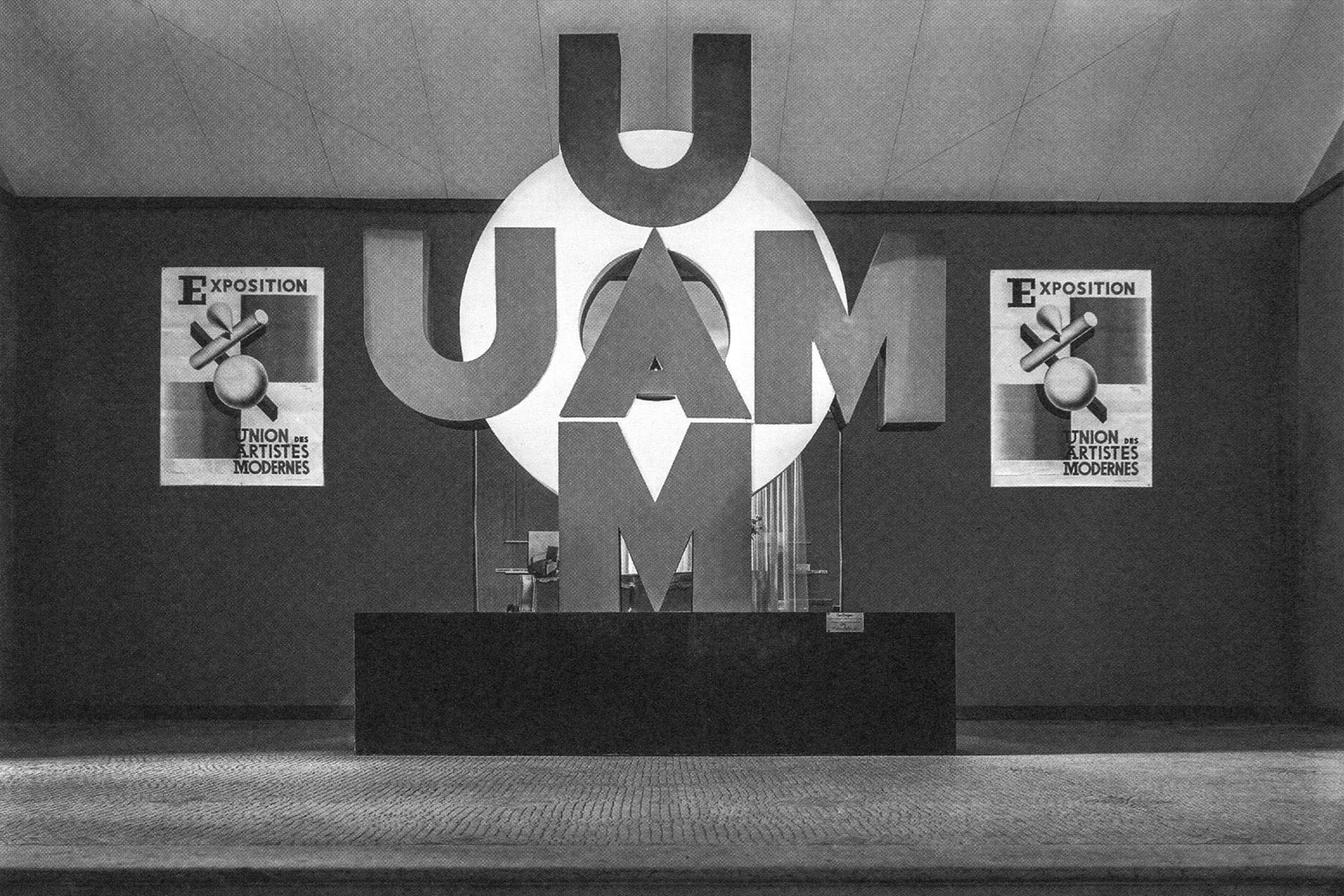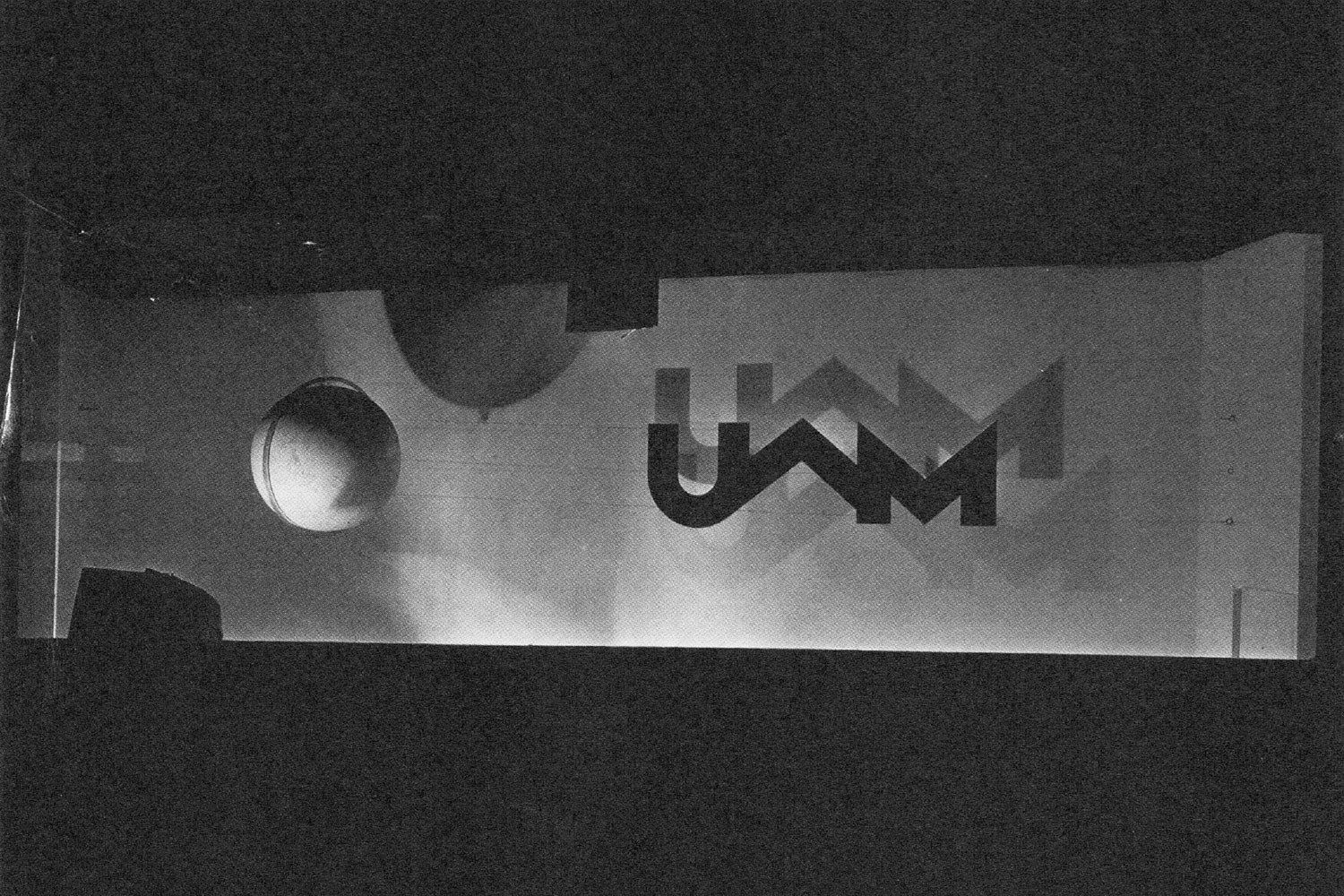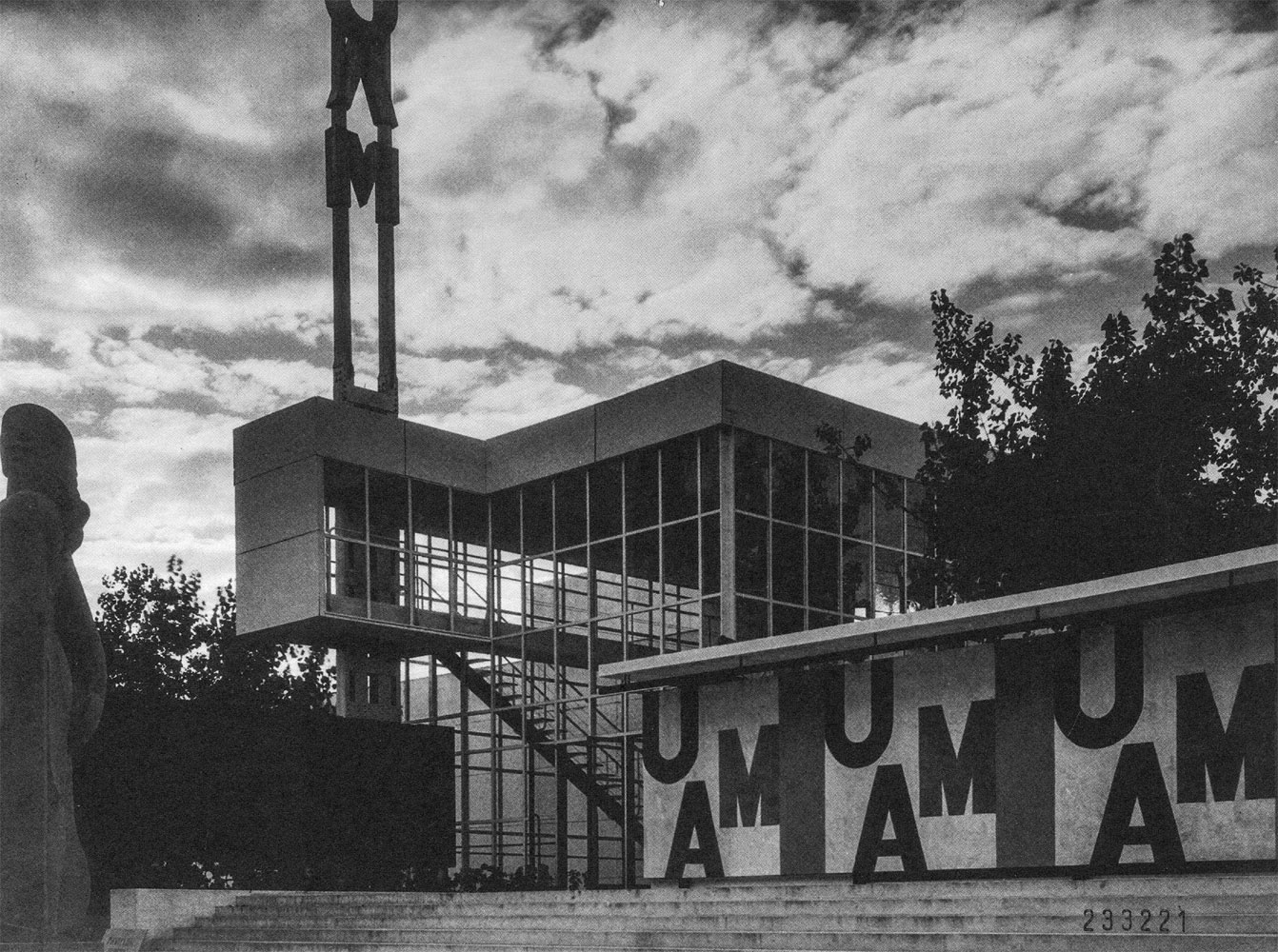UNION DES ARTISTES MODERNES
.
A Union born of a split from the art establishment of the period whose influence prevailed at the SAD, with the common goal of revitalising furniture creation in France through, for example, the application of architectural principles to the decorative arts and the use of new materials.
.
The Union of Modern Artists was created on 15th May 1929 by a constituent assembly which met at the registered office of the association, at the home of Hélène Henry, 7, rue des Grands-Augustins in Paris. The steering committee comprised Hélène Henry, René Herbst, Francis Jourdain and Robert Mallet-Stevens; Raymond Templier was the secretary and treasurer. The founding members were Pierre Barbe, Louis Barillet, Jean Burkhalter, Joseph Csaky, Etienne Cournault, Sonia Delaunay, Jean Fouquet, Eileen Gray, Robert Lallemant, Jacques Le Chevallier Pierre Legrain, Pablo Manes, Jan and Joël Martel, Gustave Miklos, Charlotte Perriand, Jean Prouvé, Jean Puiforcat, André́ Salomon and Gérard Sandoz. Pierre Chareau joined the association the following year and, alone among the moderns, Djo Bourgeois did not join the movement.
.
The group developed the principles of the association and its rules and decided at that point, to exhibit together each year, thus shunning the annual exhibitions of the Salon des Artistes Décorateurs where they had been held in low esteem for several years already.
.
The goal of the association was to gather artists with similar tendencies and spirit, to combine their efforts and to ensure its expression by means of an annual exhibition in Paris and a propaganda bulletin. A list of both French and foreign members came to consolidate this birth, which led to a first exhibition at the Pavillon de Marsan by the Union Centrale des Arts Décoratifs from 11th June to 14th July 1930. The exhibition sought to be innovative and presented an opening up of the artistic disciplines and a gateway to the most modern foreign creators as demonstrated by the invitations to Gerrit Rietveld and Bart Van Der Leck, Dutch creators belonging to the De Stijl movement. At le same temps, the Société́ des artistes Décorateursreceived the Deutscher Werkbund and the Bauhaus, at the Grand Palais, represented by Walter Gropius, Laszlo Moholy-Nagy, Marcel Breuer and Herbert Bayer.
.
Despite the indisputable quality of the works exhibited, the first presentation of the UAM remained attached to separation by stalls which prompted lively debate among the members. The UAM made known its intentions immediately, in the presentation brochure accompanying the exhibition, which favoured the rise of understated furniture, stripped of all superfluous ornamentation, following the example of Francis Jourdain the “modern therapist” who was against the majority of available furniture which was most often made in a historical style. The overall organisation was entrusted to Robert Mallet-Stevens; the entrance hall was highlighted by an illuminated frieze by André́ Salomon and the sculptures of Jan and Joël Martel. Le Corbusier, Pierre Jeanneret and Charlotte Perriand displayed the interior equipment of a residence, exhibited at the Salon d’Automne of 1929, based on the system of standard metallic coffers. Robert Lallemant submitted a nautical-style rest area with a table in glass and chrome metal, René Herbst, a piano for la maison Pleyel, a nickel-plated bridge table and Sandows chairs. Louis Sognot et Charlotte Alix exhibited a boardroom, which could be transformed into a work room created for Laboratoires Roussel and furniture designed for the Palace of the Maharajah of Indore; Émile Guillot, a set of office furniture produced by Thonet, Jean Burkhalter, a Lounge comprising chairs in painted metal tubing and cord and carpets. Pierre Chareau presented a large library and a secretaire bureau in forged iron and pearwood. The latest furniture by Jean Prouvé could be seen in the sculpture hall decorated by Jean Carlu posters. Also on display, were ornaments by Etienne Cournault, jewellery by Jean Puiforcat, jewels by Jean Fouquet and Raymond Templier. The first thirty-two members of the UAM were represented (over time the membership would extend to more than 300): Pierre Barbe, Louis Barillet, Georges Bastard, Jean Burkhalter, Jean Carlu, Paul Colin, who produced the posters for this exhibition, Etienne Cournault, Josef Csaky, Sonia Delaunay, Jean Dourgnon, Jean Fouquet, Eileen Gray, Hélène Henry, René Herbst, Lucie Holt-Le-Son, Francis Jourdain, Robert Lallemant, Jacques Le Chevallier, works by Pierre Legrain, creator of the UAM logo who had just died, Robert Mallet- Stevens, Pablo Manes, Jan et Joël Martel, Gustave Miklos, Jean-Charles Moreux, Charlotte Perriand, Jean Prouvé, Jean Puiforcat, André́ Salomon, Gérard Sandoz, Louis Sognot et Charlotte Alix, Raymond Templier. Among the invited artists were Pierre Chareau, Marcel Gascoin, Alfred Gellhorn, Jean Ginsberg, Blanche J. Klotz, Jean-Lambert Rucki, Eyre de Lanux and Evelyn Wild, Gerrit Rietveld and Bart van der Leck, Claude Lévy, Berthold Lubetkin, Hélène de Mandrot, Man Ray, Emanuel-Josef Margold, Joseph Nicolas, and Willem Pennat.
.
Admission to the group was strict since two votes against a candidate’s entry sufficed to prohibit access; this was to maintain a strong cohesion between the different members and guests. Active members of the Union undertook to hold their annual exhibition within the framework of the UAM where, as they claimed, they exhibited their works together.
.
Numerous detractors criticised their creations as being cold and clinical; or even for being out of touch with thereality of the needs of simple folk, who didn’t really have the means to buy themselves a bar or rocking chair in nickel-plated tubing.
.
Paradoxically, although the UAM creators stand up for a social art, their proposals remained unknown by manufacturers and they would, by necessity, be bound to patron-clients and luxury craftmanship favouring quality over distribution.
.
An attempted partnership of the UAM with manufacturers and the Architecture d’aujourd’hui magazine failed. Nevertheless, a fruitful collaboration and the creation of a permanent exchange commission saw the light of day between the UAM and the Office Technique pour l’utilisation de l’Acier (OTUA) whereby creators of form and producers of materials, proposed to study together the organisation of ship cabins. These projects did not, however, reach a successful conclusion.
.
In addition to these difficulties the arrival of an economic crisis which hit France in 1932 did not make the task any easier for the creators of the UAM. At the 3rd trade fair at the Pavillon de Marsan, Carlu’s poster Pour le désarmement des nations (“For the disarmament of nations”) provoked an uproar and the withdrawal of the poster by the UCAD. Even if the split with the Union Centrale des Arts Décoratifs taken into consideration, the trade show was nevertheless a success despite its numerous detractors, amongst whom were Camille Mauclair and Paul Iribe who criticised the “overly Germanic” inspiration of their creations. Paul Iribe would go as far as publishing a petition for the protection of luxury industries against the unpleasant effects of a creeping rationalism which threatened to kill them off. The fear of the foreign added to a strong nationalist sentiment, which led a number of critics to fear that the modernists had lost their own identity and the UAM was especially targeted by these accusations of collaboration with the Germans or the Soviets.
.
The trade fair of 1933 would be the last organised by the UAM; it was held due to the refusal of the UCAD to host them at the Galerie de la Renaissance from 30th May to 28th June.
.
En 1934, the year in which painters were officially invited to active members of the UAM, the group was invited by the Salon des Arts Ménagers to participate in the first Exposition de l’Habitation organised by the Architecture Aujourd’hui magazine.
.
That same year, the UAM’s manifesto Pour l’Art Moderne, Cadre de la vie contemporaine, drafted by Louis Chéronnet was presented during a soirée at the home of Robert Mallet-Stevens on 5th July 1934. This text was drafted to explain their common approach and to respond to all the most recurrent attacks confronting the creators of the UAM. A number of invitations replaced the group’s annual trade show: the Salon d’Automne trade show of 1934 and 1936, the Salon de la Lumière trade show in 1934 and 1935, and the Salon des Arts Ménagers trade show of 1937.
.
Of course, the group was not invited to the Brussels International Exposition in 1935 but the architecture category was awarded to Pierre Chareau and the Urbanism category to René Herbst.
.
1937’s International Exhibition of Arts and Technology was the last event to feature the UAM before the Second World War and the dispersion of its members, but the conditions set before them for exhibiting did not really satisfy the requirements of the group. Strictly speaking there would be no Bazaar, a collection of everyday objects and, even if part of the space was collective, the exhibition would again essentially be in the form of stands. Numerous Pavilions were produced by the members of the UAM. They would have to await the end of the war and the reformation of the UAM presided over by René Herbst, but without Robert Mallet-Stevens who had died and Pierre Chareau who was in the United States, for the idea of the “Bazaar of quality everyday objects” which had been unsuccessfully launched by Francis Jourdain in 1925 and 1937, to be finally applied. This resulted in the birth of “Formes Utiles, Objets de notre Temps” (“Useful shapes: Objects of our time”) in 1949, the first exhibition presented by the UAM after the war as part of the Salon des Arts Ménagers at the Musée des Arts Décoratifs (Museum of Decorative Arts). The exhibition showed that there existed everyday objects produced by artisans or by industry, at an affordable price that contributed to the well-being of everyone. L’exhibition was complemented by a new manifesto in 1949 reaffirming the objectives of the collective. Division was inevitable. “Formes Utiles” gradually withdrew from the UAM, becoming an independent association with René Herbst as president, on 17th December 1956. The UAMwas finally dissolved on 18th December 1958.





